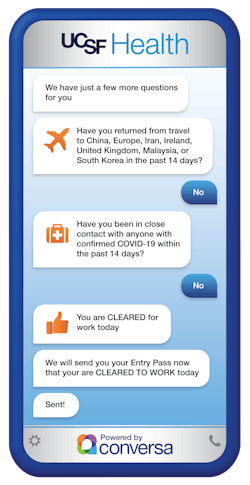Across the U.S. these days, in the face of a growing healthcare crisis, patient care organizations and digital health companies are teaming up to offer and deploy solutions that support different ways clinical workflows could be automated and virtualized. These include real-time virus tracking, online symptom diagnosis, and delivering care remotely, to name a few.
In Washington State, the Seattle area was one of the first hit with COVID-19 cases in the U.S., leading TransformativeMed—a company focused on electronic health record (EHR) usability—to offer its COVID-19/Core Work Manager (CORES) app to Seattle-area hospitals and medical centers free of charge during the COVID-19 outbreak. The app fully integrates and is embedded within Cerner's EHR, allowing providers to track patient tests and segment them based on their test results, as well as monitor symptoms checklists, track lab results, react to summarized comments and submit information to the Washington State Health Department, according to company officials.
TransformativeMed originally started as a project within the University of Washington Medical Center, and today is providing all Cerner Millennium hospitals free access to its EHR-embedded Core COVID-19 App—regardless of location. Erik van Eaton, M.D., a board-certified surgeon and faculty member at University of Washington, says the tool essentially acts like a dashboard, instantly displaying a list of patients who have been tested for COVID-19, as well as showing inpatient and outpatient status, pending test results, the patients’ current location, and their precautions. It also has the ability to flag patients who need confirmatory testing, and caregivers can “pin” comments about patients’ COVID-19 status and history, which are then used to contact outpatients to inform them of test results, van Eaton explains. “All those facts all displayed on the screen and can be updated in real time. You don’t have to open a patient’s chart,” he says.
van Eaton notes the dashboard operates differently than an EHR as the latter system has mostly pre-fabricated patient lists with just basic elements included, and while developers and their customers can sometimes work together to better customize the technology, “it’s hard to get the EHR system, as built, to adapt quickly,” he says.
The primary users of the dashboard, says van Eaton, are infection control and infectious disease clinical service professionals. And at each of the health system’s facilities, a “COVID-19 triage doctor” is deployed—either an infectious disease doctor, internist, or hospitalist—who is in charge of the ebb and flow of the COVID-19 patients for a 12-hour shift, and who also oversees the dashboard, van Eaton explains.
Without this tool, van Eaton acknowledges that a patient’s status likely wouldn’t be known until his or her chart was opened. The early results have been much better communication between providers, he notes, but also a general improvement in being able to get real-time information about patients. “Our EHR, as it comes from the vendor, was not set up for that,” he admits.
Ensuring workers are healthy at UCSF
Meanwhile, in California, UCSF Health is working with healthcare technology company Conversa Health to leverage its COVID-19 Employee HealthScreener tool—one of many resources the vendor has rolled out in response to the pandemic—that helps the health system screen its employees daily to ensure that anyone who might be infected will not come into contact with patients.
In mid-March, San Francisco received a city mandate to start screening employees before they entered the hospital, recalls Aaron Neinstein, M.D., director of clinical informatics at the UCSF Center for Digital Health Innovation. At first, he explains, there were long lines of employees, sometimes in cold and rainy weather, waiting to get into work, but in just one week, a rapid cycle development team was created between the health system and vendor to launch the screening tool, which is an interactive branching questionnaire that ask users questions about risk factors related to COVID-19. These factors of course change as more knowledge about the virus is gained, Neinstein notes.
“We needed a low-friction tool; one with no sign-up required or app to download. We also [needed] the ability to iterate on the logic and clinical care pathways, since guidelines and risk factors change on a near daily basis,” he says. The result is the screening tool that asks about risk factors and symptoms. Then the output either “passes” the employee on his or her smartphone—similar to an airline boarding pass—allowing the person to get through the front door at work, or it recommends the employee go to the health clinic for further testing and care, Neinstein explains.
“Within a week, we went from idea to prototype to pilot launch,” Neinstein says. “Now we are looking at expanding the deployment to other UCSF locations. Today, thousands of people are using the tool each day to get into work. The screening time at the door went from 40 seconds per employee down to 8 seconds. When you have hundreds or thousands of people showing up for a shift at 7 a.m., that time saved adds up,” he says.
Other ways tech is helping
Another common approach companies have deployed is helping hospitals triage the influx of patients seeking advice on COVID-19 or other medical care, with the idea to point patients to the most appropriate care setting so that health systems can better manage inflow of patients. Around the country, hospitals are preparing for the worst-case scenario of bed and supply shortages, depending on the state’s needs.
And, of course, there is no shortage of stories touting the use of telehealth during a time when in-person care increases the risk that others—including those who are delivering care—could get the virus. At USCF, for instance, Neinstein reports that as of a few weeks ago, the organization’s ambulatory video visit rate has gone from 2 percent per day to almost 50 percent per day.
What’s more, at Hardin Memorial Hospital in Elizabethtown, Ky., healthcare workers are deploying hands-free technology from healthcare communications company Vocera that can be used under isolation gowns, hazmat suits, and personal protection equipment (PPE) to facilitate real-time communication and collaboration between professionals, even if they are isolated in ICUs and caring for patients, or forced into quarantine and working remotely.
Deanna Parker, R.N., assistant vice president of the emergency department at Hardin Memorial, notes that in the midst of trying to conserve PPE, without the Vocera device, all the equipment would have to be taken off just for a clinician or nurse to reach his or her smartphone. “There’s always a risk with taking on and off your PPE because you can have contamination. With [this tool], physicians have the ability to call right into a room, and ask for the nurse in room 12 [for example], who may be already in room 12 providing care to a patient. And that nurse does not have to leave the room, does not have to take off his or her PPE, and has the ability to answer the call hands-free. They just have to accept the call and they can then communicate with the physician,” Parker explains.
In the end, health systems need to “leverage all the tools and offerings deployed in their system and work to connect the dots between various initiatives such as transfer center services, telehealth, and centralized command centers so patients care can be effectively managed, as we are now starting to stand up temporary hospitals,” offers Neha Sachdeva, the managing director for KPMG’s healthcare and life sciences practice.
Healthcare Innovation will continue to update and inform readers on these digital health/patient care organization partnerships in the fight against COVID-19.



